Thanks to all the people who have contributed to this week’s newsletter: Angelo Eliades, Choon Yin Yeok, Jeremy Mather, Jo Douglas, Karin Motyer, Laura Finch, Lili Dieguez, Mala Plymin, Maude Farrugia, Megan Goodman, Morgan Koegel, Pam Jenkins, Ros Hardy, Stella Ramos, Stephen Onians, Vanessa Nitsos Chan and Whitehorse Urban Harvest Swap.
Which farmer’s markets will be happening this weekend?
On Saturday: Coburg.
On Sunday: Alphington, Eltham and Yarra Valley. Yes, that’s right, Yarra Valley Farmers’ Market has re-started!
Community Garden news
Kevin Heinze GROW in Doncaster are holding some free social gardening sessions for Manningham residents. These sessions will “provide people in the community with genuine, supported opportunities to connect with others whilst taking care of plants, pruning and potting up“. The sessions are being held three times a week during July, August and September on Tuesdays (12.30-2.30pm), Thursdays (12.30-2.30pm) and Saturdays (9.30-11.30am). To book your slot, contact them by phone (9848 3695) or email.
Food swap news
The three food swaps run by Transition Darebin have re-started: Reservoir, Fairfield and Preston/Thornbury.
Vasundhara’s recipes of the month – rice
The theme for Vasundhara’s three recipes this month is rice. The three recipes are:
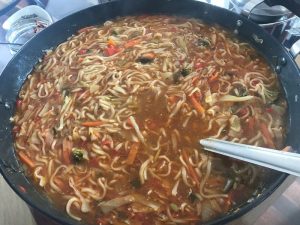 |
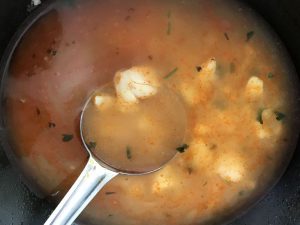 |
 |
| Noodle soup (aka thukpa) | Potato soup | Spinach and chickpea flour soup |
Like all of Vasundhara’s recipes, the recipes are plant-based.
As I’ve got space, I’m going to put my favourite of the three recipes (noodle soup (aka thukpa)) in full below but you will have to go to the website to read the other two (potato soup and spinach and chickpea flour soup).
Noodle soup (aka thukpa)
Thukpa tastes best when there are cabbage and carrots in it.
Ingredients
1 cup cabbage, thinly sliced
1 cup carrots, julienne
1 cup capsicum, julienne
1 cup onions, julienne
1 cup any green vegetable, finely chopped
1 inch ginger
3-4 cloves garlic
1 tomato, puréed
4 tablespoon oil
½ tablespoon salt
1 portion noodles
4 cups water (minimum)
Method
Heat the oil. Add the ginger and garlic. Cook well.
Add the tomato puree and cook thoroughly until it has dried and you see more oil and almost no liquid.
Add the onions and mix well. Add the cabbage, carrots and capsicum.
Sautée the mixture well. Sautéing everything nicely is really important in this recipe.
Add water to the veggies.
Boil the noodles. When they are done, add them to the soup.
Add the green vegetables before serving.
Read more of Vasundhara’s recipes on our website.
Vasundhara Kandpal is a professional cook who operates a meals delivery service called Green Karma in Briar Hill, Eltham, Eltham North and Montmorency. Read her menu and order.
Yes, you did know!
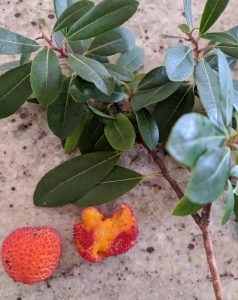 Last week, Velyne Moretti asked what the fruit tree was in her photo. Well, lots of you did know that it is an Irish strawberry tree (Arbutus unedo). Thanks to Angelo, Heather, Jeremy, Karin, Lili, Maude, Morgan, Pam, Ros, Stephen and Vanessa for all taking the time to write in with the answer. Here are a few of their comments:
Last week, Velyne Moretti asked what the fruit tree was in her photo. Well, lots of you did know that it is an Irish strawberry tree (Arbutus unedo). Thanks to Angelo, Heather, Jeremy, Karin, Lili, Maude, Morgan, Pam, Ros, Stephen and Vanessa for all taking the time to write in with the answer. Here are a few of their comments:
Angelo Eliades: “The fruit is edible but very gritty, tasting like strawberries and sand mixed together!“
Karin Motyer: “I’m sure that you and others know that Velyne’s photo is of and Irish strawberry.” [Editor: well we should know because Karin herself sent in a picture of one for our 13th May newsletter.]
Maude Farrugia: “I wrote a guide to them in the latest issue of Pip Magazine, including recipe for very yum Irish strawberry jam.“
Pam Jenkins: “ I have never tried them but you can make jam with them. I have heard that they are not very tasty just straight off the tree and that the jam is not much better!“
Ros Hardy: “As Velyne says, the birds love them but I am not sure if they are suitable for human consumption.“
Stephen Onians: “The fruit is edible when ripe. It has a slight narcotic effect and should not be eaten in large quantities. It makes good jelly. Your local council may have it listed as a weed.“
Finally, someone has sent in a recipe for Irish strawberry jelly.
Ingredients: Irish strawberries, sugar and lemons.
Cut the berries. Cover with cold water and boil for 2 hours. Strain and measure the juice. To every litre, allow 250g of sugar and juice of ½ lemon.
Bring to the boil, stirring, then simmer slowly for 2 hours until it forms a jelly.
Pour into sterile containers and store in fridge.
Do you know?
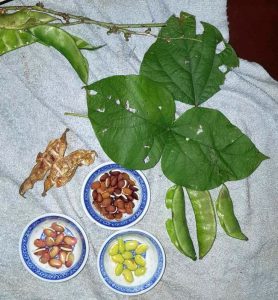 Stella Ramos has written in: “This plant is growing in my brother’s backyard. What is it, is it edible by humans and can he feed it to the birds? The dark beans are those which are dried out. The pods are a bit fluffy. All the beans have a distinct white line along the edge. My brother is not sure if it’s safe to eat but he tried some and says it tastes a bit like peas but not as sweet.“
Stella Ramos has written in: “This plant is growing in my brother’s backyard. What is it, is it edible by humans and can he feed it to the birds? The dark beans are those which are dried out. The pods are a bit fluffy. All the beans have a distinct white line along the edge. My brother is not sure if it’s safe to eat but he tried some and says it tastes a bit like peas but not as sweet.“
Leaf, Root & Fruit’s gall wasp experiment
Three years ago, Leaf, Root & Fruit purchased some citrus trees and have been applying different treatment for citrus gall wasp to the different trees. Every 6 months, they update their results and their results page has just been updated. Their current conclusions are as follows:
- You need to fertilise your trees regularly if you want more fruit.
- It doesn’t matter if your tree has galls or not, it can still be productive.
- If you want to prevent gall wasps from infesting your tree then kaolin clay looks to be a promising method to do so.
Reader photos
Last week’s theme – meals
4 people sent in photos, each with a little story, attached. In addition, Laura Finch sent in a picture of the meal for two that she won in the pets’ photo competition.
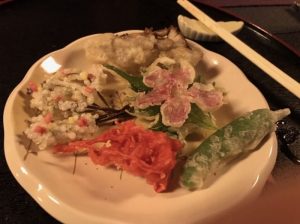 |
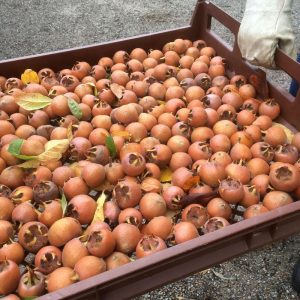 |
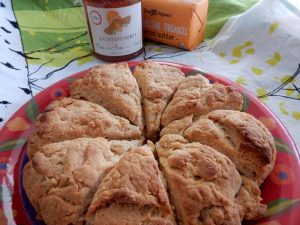 |
| Choon Yin Yeok | Jo Douglas | Karin Motyer |
 |
 |
|
| Mala Plymin | Laura Finch |
Choon Yin Yeok: “This is one of the courses I had in a vegetarian Shinto temple in Kyoto. Mushroom dumpling, rice crackers, okra, deep fried carrots and puffed rice.“
Jo Douglas (Monsalvat’s Head Gardener): “For many years, the medlars at Montsalvat just fell off the tree and fed the soil beneath it. This year one of our volunteers, Barbara, decided that they shouldn’t go to waste and organised their picking, ‘bletting’ and transformation into medlar jelly. Medlars must be ‘bletted’, which involves storing them in a single layer in a rather cool place until they are soft and brown inside. They’re ready when they are very soft and squishy to the touch. The medlars were distributed to four different kitchens and the solids left after straining also became medlar & apple crumble and medlar chutney. “
Karin Motyer: “These are homemade honey scones. It is a simple and quick recipe with honey, butter, self-raising flour and milk. Note, in the background, the jar of honey from Backyard Honey that I won in the bees’ photo competition.“
Mala Plymin: “Homemade roti, rice, fried okra and pumpkin curry. The pumpkin is from our garden. We picked it when the skin was still soft. So tasty. The okra is from the local Community Grocer.“
Doris Glier (Laura Finch’s mother): “We had a lovely evening out at Urban Grooves. Laura enjoyed her healthy green smoothie whilst sharing a mouth-watering starter tapas plate with her sister. The girls had had a big day out with their bikes so they still felt quite hungry when their appetizingly decorated main meals arrived.“
This week’s theme – chickens and eggs
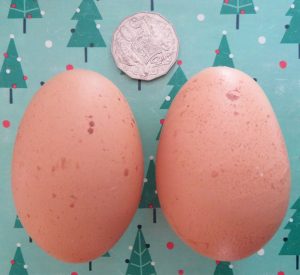 This week’s photo theme will be ‘chickens and eggs’. Quails, etc will also be allowed. Send me your interesting photos, together with a title and (if you want) a story, and I will publish them next week.
This week’s photo theme will be ‘chickens and eggs’. Quails, etc will also be allowed. Send me your interesting photos, together with a title and (if you want) a story, and I will publish them next week.
To get you going, here is a photo of some of the monster eggs that one of my chickens lays. Both 101 grams.
Guy’s veggie growing tip – crop rotation
If you ever grow veggies, they are likely to include tomatoes and you will probably grow tomatoes every year. But you shouldn’t grow them in the same place every year. Ditto any other vegetable. This is for two main reasons. First, most pests and diseases prefer specific types of plant; if you change the types of plants that you grow in a specific place from year to year then it helps to break the pest or disease’s lifecycle so you will have less pests and fewer diseases. Second, each type of plant places particular demands on the soil in terms of nutrient extraction, etc; if you change the types of plants that you grow in a specific place from year to year then it gives your soil a rest from the particular burdens placed on it.
What is true for specific species of vegetable is also true for groups of vegetables. So, for example, tomato, capsicum, chilli, eggplant and potato are all in the same family (solanums), all attract the same pest & diseases, and all place similar demands on the soil.
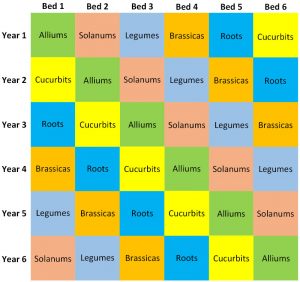 The discussion in last week’s newsletter talked about 5 groups of closely related vegetables plus a miscellaneous list. Divide the miscellaneous list into ‘roots’ and ‘leafy greens’ and you get 7 groups in total: alliums, legumes, brassicas, cucurbits, roots, solanums and leafy greens. The ‘leafy greens’ group is not relevant to crop rotation – just plant them wherever and whenever you have gaps. So, the ideal is a 6-bed, 6-year rotation for the other 6 groups.
The discussion in last week’s newsletter talked about 5 groups of closely related vegetables plus a miscellaneous list. Divide the miscellaneous list into ‘roots’ and ‘leafy greens’ and you get 7 groups in total: alliums, legumes, brassicas, cucurbits, roots, solanums and leafy greens. The ‘leafy greens’ group is not relevant to crop rotation – just plant them wherever and whenever you have gaps. So, the ideal is a 6-bed, 6-year rotation for the other 6 groups.
If you have fewer than 6 beds, then you can either combine some of the groups (e.g. alliums and roots) or omit some of the groups (e.g. brassicas).
You then have to decide the order of how a bed should change over time. A principle here is that heavy feeders should, where possible, alternate with light feeders. So, for example, legumes (light) – brassicas (medium) – alliums (light) – cucurbits (heavy) – roots (light) – solanums (heavy).
And, finally, you have to decide when during the year to rotate the crops, with the obvious time being after the summer harvest.
See our website for a slightly longer discussion, including which vegetables are in which groups.
Read more of Guy’s veggie growing tips.
Growing peas
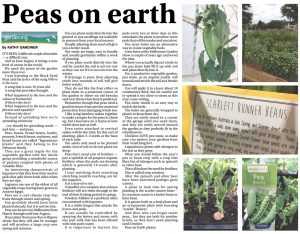 Newsletter reader Kathy Gardiner’s article in this month’s Warrandyte Diary is about growing peas.
Newsletter reader Kathy Gardiner’s article in this month’s Warrandyte Diary is about growing peas.
Meg’s social isolation week
The raspberries are still fruiting, a couple of large red berries glowing at the ends of some of the canes. I grow Nootka which provides two crops, one in summer and one in autumn. It is quite late to be getting ripe fruit. I guess I will have to wait a little longer before cutting back the older summer canes and tying in the fruiting ones.
The potato seedlings emerging in the compost heap from past crops reminds me that it’s time to plant new certified seed potatoes. I usually plant some now when I have my pick of varieties and some more towards the end of August, when stock is often discounted. This provides a staggered harvest. The ones planted now will emerge in early spring, giving us new potatoes late November that you can carefully dig to find without pulling out the main plant. The larger main crop will be enjoyed in summer.
Last year I grew Kipfler, King Edward and Nicola. This year I am starting with Kipfler and Kennebec for something different. Kipfler seems to need longer to develop good-sized tubers. Potatoes are easy to grow in deep containers like large plastic trugs (with drainage holes) and I have two that I keep for this purpose. I also plant the seed potatoes in a trench and mound the soil so that they are buried around 10cm below the soil and around 20cm apart. In both cases, as the seedlings emerge, I add layers of compost and pea straw (leaving the growing tip exposed) to protect the crop and encourage more tubers.
I love roast potatoes, but new potatoes need only a little olive oil or butter while warm and a few fresh herbs. Nothing else.
Best roast potatoes
Boil potatoes (skin on or off) until just tender.
Drain and add to a roasting dish. Break up the potatoes slightly, roughing the edges. Brush the tops with olive oil, scatter with finely chopped thyme & rosemary and sprinkle with salt & pepper.
Bake at 220degC for around 20-30 minutes.
Read more of Meg’s recipes on our website.
Which link was clicked most times in the last newsletter?
The picture of Irish strawberries.
Joke of the week
What did the cherry say to the cherry pie? “You’ve got some crust.”
Upcoming online events
If you know of any events other than those listed below, email me.
Newly announced events
Grow your own fruit trees: Wednesday, 24th June, 7-8.30pm; free; organised by Yarra Ranges Council. Read more and book on EventBrite.
Composting and worm farming: Thursday, 25th June, 10am-11.30am; $15; organised by Living & Learning Nillumbik. Read more and book on their website.
Wonderful world of worms (for kids): Thursday, 25th June, 4-5pm; free; organised by Edendale. Read more and book on WeTeachMe.
Beeswax wraps: Sunday, 28th June, 10am-midday; $50; organised by CERES. Read more and book on Humantix.
Culturing fungi on agar for beginners: Sunday, 5th July, 2-3.30pm; $28; organised by MYCOmmunity. Read more and book on their website.
Backyard beekeeping basics: Tuesday, 28th July, 7-9pm; $50; organised by CERES. Read more and book on Humantix.
Previously announced events
The Jesuit Social Services’ Ecological Justice Hub, together with Moreland City Council and the Australian Food Sovereignty Alliance, is organising an online event entitled COVID-19 and food systems: impact, response and pathways to transformation on Thursday, 18th June, 6-8pm. $11. Read more and book on EventBrite.
Open Table now offer their weekly no waste cook club workshops free and online on Saturdays. As well as cooking (which is actually optional), you will learn about food waste and composting. Register on EventBrite.
Whitehorse Council are publishing on their Youtube channel a video each Monday at 9am on various aspects of sustainability, including beeswax wraps (on 22nd June).
Newsletter reader Chloe Thomson is doing free, weekly podcasts on gardening for Bunnings.
Pip Magazine (some of whose journalists live in North East Melbourne) are producing a series of videos entitled simple skills for self sufficiency.
Good Life Permaculture are producing a series of videos entitled crisis gardening.
All The Dirt is a weekly podcast about gardening.
